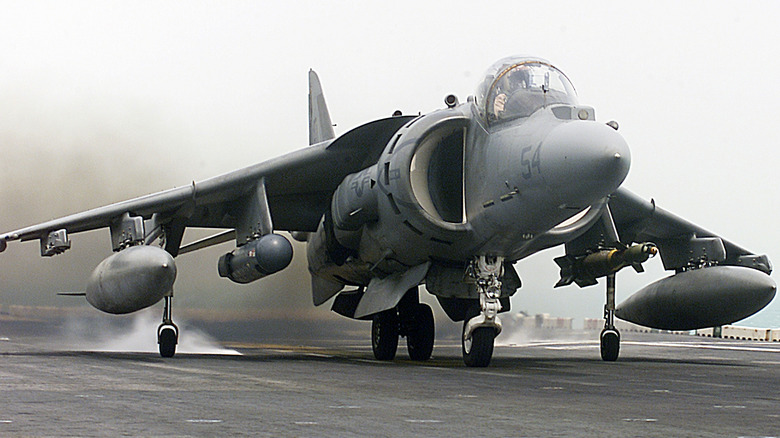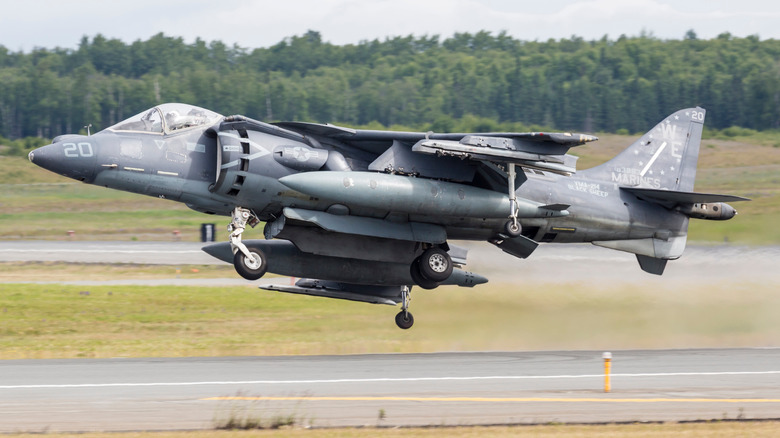The Incredible Capabilities Of The Legendary Harrier Jump Jet
For nearly four decades, the AV-8B Harrier II was the only short takeoff, vertical landing (V/STOL) jet aircraft in the U.S. military's inventory. What that means is that this unique aircraft can move up and down vertically like a helicopter, allowing it to take off and land in compact spaces like jungle clearings or the deck of a ship. As it that's not enough, it can also hover, fly sideways, and even go backwards.
How is this magic accomplished? Whereas most jet engines only produce forward thrust, the Harrier II has four thrust nozzles, which are adjustable through a range of motion. But when it comes time to cover some distance, the AV-8B Harrier II is also highly capable as a regular horizontal flying jet aircraft, capable of reaching a top speed of 673 MPH.
The Harrier II's predecessor, the Hawker Siddeley Harrier aircraft from the 1960s, received a significant and necessary bump in size, range, and cargo handling capability during the 1970s — courtesy of a transatlantic venture between McDonnell Douglas (now Boeing) and British Aerospace.
The focal point of the Harrier II revamp was its massive Rolls-Royce "Pegasus" turbofan engine with 22,000 pounds of thrust. The first pre-production Harrier II took to the skies in 1981, and by 1985, the new model was fully tested and entered service with the U.S. Marine Corp (USMC).
[Featured image by HLW via Wikimedia Commons | Cropped and scaled | Public Domain]
A college student tried to buy one
After receiving initial deliveries of the improved craft, the Marines didn't waste any time pressing the Harrier II into service. It's a seasoned veteran of the first and second Gulf Wars (1990 and 2003), Operation Enduring Freedom in Afghanistan, and other NATO conflicts. It was particularly instrumental in the first Gulf War, Operation Desert Storm, where Harrier II aircraft delivered more than six million pounds of weapons and other supplies to the front lines.
The AV-8B Harrier II received another upgrade in 1992, becoming the AV-8B Harrier II Plus. Besides a more powerful engine, the Plus adopted advanced electronics for improved operation at night and in inclement weather. Production of the aircraft ended in 2003, but Boeing continues to support AV-8B Harriers flown by the United States, Italy, and Spain. By 2029, it will finally be phased out in favor of the Lockheed Martin F-35B Lightning II. In total, more than 340 units were built.
The Harrier II was also involved in an infamous advertising campaign for Pepsi Cola in 1996. Ad executives thought it would be humorous to run a television commercial promising one of the jets to any Pepsi drinker able to collect seven million reward points — a goal presumably unachievable.
However, college student John Leonard found a loophole. Instead of collecting Pepsi cans, the Pepsi Points could be purchased at a cost of 10 cents each, which means that the $23-million jet could be obtained for the bargain price of $700,000. Leonard eventually sued Pepsi for the plane, but the court ruled that the promotion was obviously meant to be a joke. What was not a joke was the avalanche of bad publicity that Pepsi received as a result.

